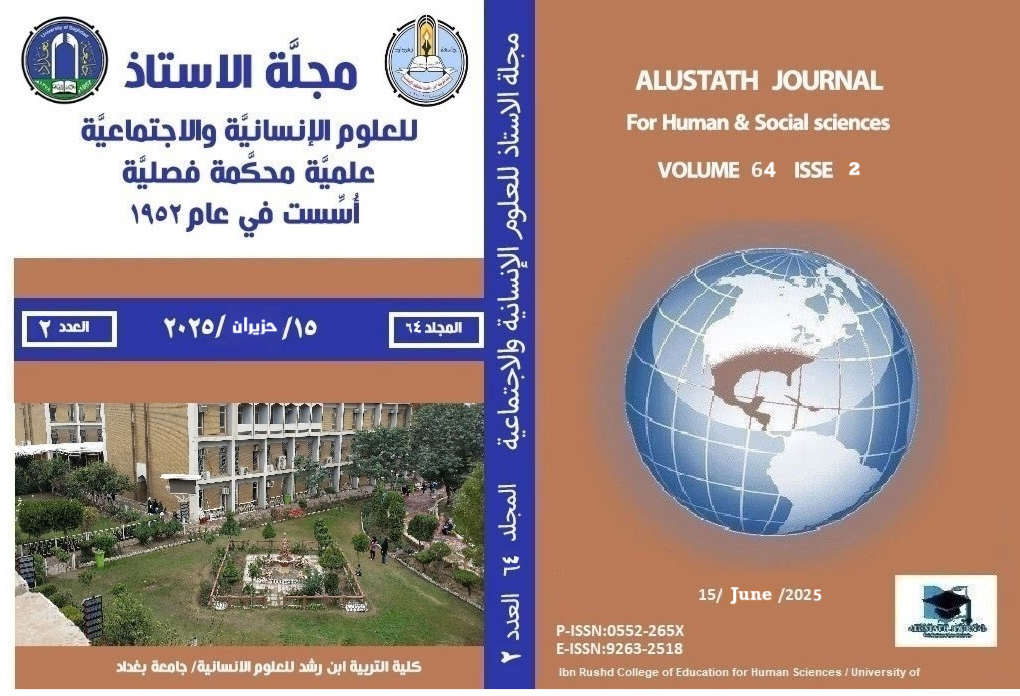Development of Children's Understanding of Conflict Resolution
DOI:
https://doi.org/10.36473/w0ssga74Keywords:
conflict resolution, understanding, development, Piaget's theoryAbstract
Childhood is one of the most important stages in a person's life, as the first personality traits are formed and the basic building blocks for mental, social, and emotional growth are laid. Hence, studying how children acquire concepts is a very important topic, so our research came to present one of these concepts, as the research topic aims to understand conflict resolution for Iraqi children, and aims to identify: 1. Understanding conflict resolution according to the variables: A. Age (5, 6, 7( B. Gender (males, females( 2. Identifying the significance of differences according to the variables: A. Age (5, 6, 7( B. Gender (males, females( The research sample included (180) boys and girls distributed over three ages (5-6-7) years, (60) children for each age group and distributed equally between the sexes. The researcher prepared a tool to measure children's understanding of conflict resolution. It consisted of eight stories interspersed with two questions on each story and a qualitative question. The researcher extracted the apparent validity. The stability of the tool was verified by the Cronbach's alpha coefficient and the test-retest method. The results of the research were as follows: 1. Children at the age of (5) years do not have an understanding of conflict resolution. 2. Understanding conflict resolution appears in children at the age of (6) years. 3. Children at the age of (7) years have a high understanding of conflict resolution. 4. There is no effect of gender in understanding conflict resolution. In light of the results of the current research, the researcher proposes a set of conclusions, recommendations and proposals.
Downloads
References
• Abu Ghazal, Muawiyah. (2006): Theories of Human Development and Their Educational Applications, 1st ed., Dar Al-Masirah for Publishing, Distribution and Printing, Amman.
• Abu Jado, Saleh Mohammed Ali. (2004): Developmental Psychology - Childhood and Adolescence, 1st ed., Dar Al-Masirah, Amman, Jordan.
• Bandura, A. (1986). The explanatory and predictive scope of self-efficacy theory. Journal of Social and Clinical Psychology, 4, 359-373. doi:10.1521/jscp.1986.4.3.359.
• Cao Y, Wang H, Lv Y and Xie D. (2023): The influence of children’s emotional comprehension on peer conflict resolution strategies. Front. Psychol. 14:1142373. doi: 10.3389/fpsyg.2023.1142373.
• Dunn, J. and Slomkowski, C. Shantz, C. U. and Hartup, W. W. eds. (1992): Conflict and the development of social understanding, Conflict in child and adolescent development p. -70 Cambridge University Press, Cambridge, UK.
• Fadhel, Rana Zuhair and Mahmoud Hadeel Khalid (2016) The experience of emotional suppression among adolescents and its relationship to the need to overcome, Al-Ustadh Magazine, Issue 216, Issue 2, Baghdad.
• Halmatov Medera. (2018): Conflicts and Conflict Situation Settlement of Children of 5-6 Years Attending Pre-school Educational Institution, Department of Preschool Education, Faculty of Education, Ağrı İbrahim Çeçen University, Turkey, DOI: 10.13189/ujer.2018.061128.
• Hamad, sanaa abdul karim and Nada , qasim Muhammad. (2017). The experience of critical thinking skills among adults, al-ustadh magazine. Issue 223, Baghdad.
• Hornby, A.S & Parnwell. (1959). An English Reader's Dictionary London. oxford University Press.
• Jaafar, Ghada Ali Hadi. (2022) The development of motor thinking in children. Al-Ustadh Magazine, Issue 2, Issue 61, Baghdad
• Jaafar, Zahra Musa and Mahdi Umm Hashim (2015) Development of inner speech for ages (6-12) years, Al-Ustadh Magazine, Issue 212, Issue 2, Baghdad.
• Jeremy Pollack. Five Tools Every Leader Can Use to Improve Their Workplace Culture Immediately, Peaceful Leaders Academy A Pollack Peacebuilding Company, Alwin Conflict Resolution Training, 2024, p3.
• Karkoush, Maryam Hussein. (2020): The Development of Children's Understanding of Humility, Unpublished Master's Thesis, College of Education - University of Baghdad.
• Nancy. Carlsson-Paige: (1992). "Children's understanding of conflict : a developmental perspective." Doctoral Dissertations, University of Massachusetts Amherst. Doi: https://doi.org/https://doi.org/10.7275/14755437 .
• Roberts Adam, Ash, Timothy Garton(1990): " Civil Resistance and Energy policy, The experience of non- violent action of Gandhi to the present time Oxford, UK, University press.
• Zahran, Hamed Abdul Salam. (2005): Developmental Psychology - Childhood and Adolescence, 1st ed., Alam Al-Kutub for Publishing, Distribution and Printing, Cairo.
• Zartman, William (2000): Conflict Mangament the long and short, Sais review 20 no 1V, Ethiss and Behavior.
• Zeller,R & Counnunes, F.(1980): Measurment in the social sciences :The link between theory and data, Cambridge, London












